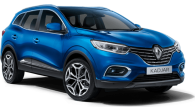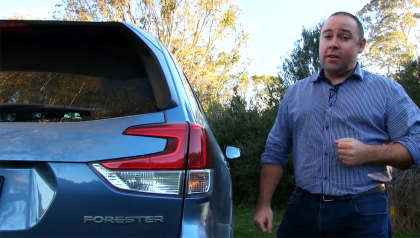Has the best midsize SUV just gotten even better? In this review of the 2022 Toyota RAV4, you’re going to find out!
Rather than completely rethink things, the 2022 Toyota RAV4 is more of a refinement of the recipe for what has long been considered the best midsize SUV on the market in Australia.
There have been new variants added, some versions dropped, better availability of the petrol-electric hybrid version, and price adjustments across the line-up.
So we figured it was time to see what’s changed, and whether it’s even better now because of the changes. Read on to find out, or watch my video for the rundown.
Toyota RAV4 2022: Cruiser (2WD)
| Engine Type | Inline 4, 2.0L |
|---|---|
| Fuel Type | Unleaded Petrol |
| Fuel Efficiency | 6.0L/100km (combined) |
| Seating | 5 |
| Price From | $38,940 - $45,760 |
| Safety Rating |
|
Does it represent good value for the price? What features does it come with?
9 / 10
Is it an overstatement to say the 2022 Toyota RAV4 is one of the best, if not the best value SUV on the market?
It doesn’t have the lowest starting price, but it also doesn’t quite stretch the budget as far as some rivals.
However, it’s the mix of variants available across the range that make it appealing on the financial front, especially given the brand has just added more hybrid versions which, honestly, represent real-world value that no other rivals at this price point can match.
The GX model still opens the range, though the price-leading petrol-manual model has been dumped as almost nobody bought it.
Instead, the GX 2.0-litre petrol CVT 2WD model starts at $34,300 (all prices listed are MSRP, before on-road costs). There is a 2WD hybrid version at $36,800, and the AWD hybrid GX is $39,800.

The 2022 Toyota RAV4 GX models score redesigned 17-inch alloy wheels, LED headlights and daytime running lights, newly added LED fog lights, new LED interior lights, a 4.2-inch digital driver info screen, an 8.0-inch touchscreen media system with smartphone mirroring tech (Apple CarPlay/Android Auto), digital radio, five USB ports, cloth seat trim and the option of a full size spare wheel for the hybrid model (higher grades get a space-saver temporary spare). If you want sat nav it costs an extra $1000 and is only available for the hybrid model. GX Hybrid models get dual zone climate control, while GX petrol versions have plain old manual air-con.
The GXL model steps up the price points to $37,825 for the petrol CVT, $40,325 for the hybrid 2WD and $43,325 hybrid AWD.
For the extra $3525 over the GX, the GXL grade adds a few extras you might find appealing, including: roof rails, 18-inch alloy wheels (remember, no full-size spare), front and rear mud flaps (GX has rear only), keyless entry with proximity unlocking and push-button start, a wireless phone charger, an auto-dimming rearview mirror, sat nav, dual-zone climate control, and “premium fabric seats” as well as a “premium gear selector”. The 2022 update also saw the introduction of illuminated door switches - very fancy.
The next step up the range is the model Toyota hopes will shift some demand away from the higher grades. It’s the new XSE trim, which is available in hybrid only, priced at $42,825 for the 2WD and $45,825 for the AWD.
By asking $2500 more than the GXL, the XSE justifies its price point with the inclusion of dark exterior highlights on the bumpers, grille, fog light garnishes, door mouldings, mirror caps and the roof is black, too. Plus it gets 18-inch black alloy wheels, and inside there is a black headliner.
The XSE models score fake leather trim called “Softex”, heated front seats, and a 10-way power-adjustable driver’s seat, leather-accented door trims, interior mood lighting, and an electric tailgate. There’s also a part-digital dashboard with a 7.0-inch display - small by class standards, as many rivals now offer 12.3-inch digital driver screens.

Above it is the Cruiser model, which is still available as a 2.0L non-hybrid auto powertrain ($42,500), hybrid 2WD ($45,000) or hybrid AWD ($48,000).
The Cruiser does away with the black roof finish of the XSE, but ups the game with leather-accented seats, three-stage heated front seats with ventilation/cooling, and there is eight-way power adjustment for the passenger front seat, too.
Additionally, Cruiser has redesigned 18-inch alloys, the driver’s seat has memory settings, and there’s a new digital rearview mirror that uses a camera to offer a wider field of view. There are also auto-folding door mirrors, and the Cruiser scores a nine-speaker JBL stereo system.
Choose the range-topping Edge model and you can now have it with the choice of the non-hybrid 2.5L four-cylinder engine with AWD (details below) or the 2.5L hybrid AWD powertrain.
The 2.5L non-hybrid has a list price of $49,820, while the 2.5L hybrid version pushes this generation of RAV4 over the psychological barrier, with a $52,320 price tag.

Edge models get the distinctive model-specific front bumper and wheel-arch moulding, 19-inch wheels, the two-tone interior trim with Softex fake leather, hill descent control, and Toyota’s Multi Terrain Select drive mode dial.
Edge is the only model available with the option of a panoramic sunroof, which adds $1300 to the price and isn’t available on the hybrid Edge model.
The paint colour options available vary depending on the grade, but the premium is $675 for any colour other than Glacier White. The bright and shiny Eclectic Blue has proven a bit too eclectic for Toyota tastes, having been dumped in favour of a new Mineral Blue finish. Other choices include Silver Sky, Graphite (charcoal), Atomic Rush red, Eclipse Black, and Saturn Blue (dark blue/navy).
There are dozens of additional accessories to choose from, including roof racks, a nudge bar, floor mats, headlight and bonnet protections and more.
On the whole, it’s hard to see anyone needing much more in their RAV4 than the GXL offers, but the easy-clean nature of the XSE’s fake leather trim, and that electronic tailgate, make it the pick of the range for value.
Is there anything interesting about its design?
8 / 10
Personally, I already thought the RAV4 was one of the better looking, more rugged and masculine midsize SUVs on the market.
Plenty of rivals have gone with the more swoopy, stylised look - the Kia Sportage and Hyundai Tucson are prime examples. Then there’s the Mitsubishi Outlander with its more, er, outlandish appearance. Or more sedate styling examples like the Ford Escape and Subaru Forester.
But the RAV just continues to power on without a whole lot of change, though there are a few minor design considerations with this 2022 update. Enough has been adjusted that should be able to pick it in the traffic compared to a pre-facelift version.
Giveaways include the revised headlight design, which somehow looks a bit more Ssangyong-ish than before, while the front bumper has also seen the addition of LED fog lights.
There are new wheel designs across most grades, including a slightly more elegant look to the GXL’s rims, while the XSE really adopts the full-time black-pack appearance with its darkened exterior highlights.
As for the interior? There’s nothing different about the design, really, because it’s largely a carryover affair - well, the base GX now gets LED interior lights, which is nice, and the GXL has these spiffy illuminated door switches, plus the XSE has mood lighting like the Edge model. Ooh, la la!
I’ll go into more detail on the interior in the next section.

How practical is the space inside?
8 / 10
Practicality has long been a strong suit of the current-generation Toyota RAV4, with plenty of likeable and thoughtful inclusions.
Highlights include heaps of smart storage, incorporating a shelf that runs across the dash in front of the front passenger, and there is a small cubby on the driver’s side too. The centre console is big and includes two USB ports, and ahead of it there are two large cup holders, while in front of the shifter there’s a storage bay with wireless phone charging (on GXL and above) that also includes a USB port and 12-volt outlet.
The door pockets are big in all four doors, and the rear also has a flip down armrest with cup holders, but unlike some rivals there is only one map pocket, and it’s on the back of the passenger seat.
Speaking of that seat, something you might want to consider is just how high up it is. Anyone my height (182cm or 6’0”) or taller might find the space to be a little cramped for headroom, and that seems to be a Toyota trait for the current-gen models. I can’t say whether the Cruiser’s electrically-adjustable passenger front seat is any better, but from experience, it probably won’t be.

The controls are all nicely positioned, and I still love those rubberised knobs and dials for the climate control and volume/tuning. And that’s another nice point, the fact the Toyota still has buttons and knobs for the media system.
What isn’t as great is that the media system still runs an 8.0-inch touchscreen, which is well behind the times in terms of what the rivals are offering. Hyundai now has a 10.25-inch screen on all but the base model Tucson, while Kia runs an 8.0-inch screen on the base Sportage but a 12.3-inch touchscreen on all grades up from there.
Speaking of digital stuff, the driver info screen across the RAV4 models is a bit lacking, too. There’s a 4.2-inch display in between the dials on GX and GXL grades, while XSE, Cruiser and Edge have a larger 7.0-inch display. That’d be fine if the rest of the world hadn’t moved towards larger fully digital screens - Kia, again, offers a screen up to 12.3-inches in full colour for the driver, and MG has had that on its HS hybrid models since launch. It is a bit of a let down for a tech-heavy car. Maybe the next RAV4 model update will address that.
What isn’t a let down is the usability of the space. The rear seat is easily big enough for me to sit behind my own driving position, and at 182cm I have heaps of leg, shoulder, head and foot room. Three adults across is easily done, and if you have kids, there are dual ISOFIX points for the window seats, and three top-tether attachments, too.
A note for the family buyers out there - you can easily fit a rearward-facing baby capsule in behind the passenger seat, without the front seat rider needing to be too squished up against the dashboard.
As for boot space, there’s up to 580 litres (VDA) of cargo capacity for the RAV4, unless you opt for one with a full-size spare (GX only). That’s with the floor set to its lower point, while it’s still an impressively usable 542L (VDA) at the higher point, and if you fold down the rear seats you liberate 1690L (VDA) of boot capacity.
Choose the XSE or above if you want a hands-free tailgate with electric opening, though.

What are the key stats for the engine and transmission?
8 / 10
So I’ve sort-of made this clear already in the pricing section, but there are three powertrains you can choose from for the RAV4.
The entry-level version is the 2.0-litre four-cylinder petrol, which is available in 2WD (front-wheel-drive) only, and has a CVT (continuously variable transmission) automatic gearbox as standard. The pre-facelift RAV4 had a base model GX manual, but it has been dropped because no-one bought it.
The 2.0L - as with the rest of the RAV4 engines - hasn’t seen any change to its outputs, remaining at 127kW (at 6600rpm) and 203Nm (from 4400-4900rpm).
The other non-hybrid petrol is the 2.5-litre four-cylinder that is offered in the Edge grade. This unit sees a big power bump over the base engine, with 152kW (at 6600rpm) and 243Nm (from 4000-5000rpm). It comes only with an eight-speed auto, and all-wheel drive.

Then there are the hybrid versions.
Both use a 2.5-litre four-cylinder as the basis, but the 2WD model adds an electric motor to the mix for a maximum combined power output of 160kW. The AWD version uses Toyota’s e-Four electric rear axle with another electric motor back there, but only pushes power up by 3kW (to 163kW max. combined).
There’s no combined maximum torque figure, though Toyota states the 2.5L engine offers 221Nm at 3600rpm.
What’s missing? There’s no diesel, no turbo-petrol, and no plug-in hybrid, which is available in other markets. I guess there’s a Lexus NX 450h+ if you want that, and can justify the extra cost.
How much fuel does it consume?
9 / 10
Let’s go through the numbers, engine by engine.
The base model 2.0-litre petrol engine with CVT and front-wheel drive has an official combined cycle fuel consumption figure of 6.0 litres per 100 kilometres (ADR 81/02), Not bad, really.
The 2.5-litre four-cylinder petrol engine in the Edge is said to use a claimed 6.7L/100km.
While the official figure for fuel use for the 2.5L petrol-electric hybrid powertrain varies ever-so-slightly depending on whether you choose the 2WD/FWD model (4.7L/100km) or the AWD version (4.8L/100km).
Our real-world on-test fuel consumption for the GXL AWD hybrid model was a bit higher than that, at 5.8L/100km, but the car was brand new and had just 32km on the clock when we collected it.
Even so, that was across a mix of driving on highways, motorways, open roads and urban testing. And it’s pretty damned impressive, especially given current petrol prices.
In a small reprieve, all RAV4s can run on the cheapest 91RON regular unleaded petrol. The fuel tank capacity is 55 litres, no matter which grade you choose.
Warranty & Safety Rating
What safety equipment is fitted? What safety rating?
7 / 10
The Toyota RAV4 in its current-generation guise has been awarded the maximum five-star ANCAP crash test safety rating, and that was achieved in 2019.
However, a lot has changed since then - including the criteria to achieve the maximum score for ANCAP testing, not to mention the fact some rivals have been pushed to include more extensive standard equipment across their model ranges.
Where does that leave the RAV4? Well, it isn’t the benchmark in the segment, despite offering a pretty strong standard safety gear list.
The inclusions consist of front auto emergency braking (AEB) with pedestrian and cyclist detection, lane departure alert and lane keeping assist, blind-spot monitoring and rear cross-traffic alert, and there’s also the requisite reversing camera and parking sensors (front and rear).

Things the RAV is missing? Well, only the updated Edge models get a rear AEB system that will stop the car if it thinks you might reverse into the path of traffic, and that really should have just been rolled out range-wide.
Further, no RAV4 grade has rear-seat occupant alert to remind you to check the back seat, nor does any version have safe exit assist (which will stop you or others opening a door into oncoming traffic) or the clever junction assist that will stop you from driving through a gap you won’t safely make.
Those items are offered on rivals - the Mazda CX-5 has rear AEB range wide, while the Sportage and Tucson have the other goodies - so the RAV really is being left behind to some extent.
Further, while the RAV4 has seven airbags (dual front, front side, driver’s knee, and full-length curtain), some rivals offer additional airbag protection in the form of a front-centre airbag or rear side/thorax airbags.
What does it cost to own? What warranty is offered?
9 / 10
There are competitors with longer warranty and capped-price servicing plans, but Toyota has a bigger service network and a more affordable ownership plan than almost any other midsize SUV.
About that warranty - it’s a five-year/unlimited kilometre warranty plan, which is what most rivals have. Kia has seven years/unlimited kays, Mitsubishi has up to 10 years/200,000km.
But Toyota’s warranty plan can extend to seven years if you make sure the car has logbook maintenance carried out, and it doesn’t need to be at a Toyota dealership, either. Further, if you have a hybrid Toyota, the battery warranty is up to 10 years, so long as you service your car with Toyota, as they conduct a yearly check on the battery health if you do.

Beyond that, there’s a capped-price service plan for the RAV4 that runs to five years/75,000km, meaning the maintenance intervals are 12 months/15,000km for servicing. The cost per visit is capped at just $230 for that period, too.
The only thing that’s missing, really, is roadside assistance. Toyota asks you to pay an annual fee for it, where some rival brands include it for free… but then again, those brands also charge you more for your annual service.
What's it like to drive?
8 / 10
There’s a lot to like about the RAV4 drive experience.
In my opinion, it still offers one of the best blends of comfort, ease of use and daily-drivability of its competitive set.
I spent my time for this review in the GXL hybrid AWD model, but have tested the 2.0L CVT in the past and found it to be a good little thing. The 2.5L in the Edge is also pretty decent, but hardly the last-word in refinement.

So let’s consider the hybrid powertrain first and foremost, because - according to Toyota - more than 70 per cent of customers choose the petrol-electric option, and the percentage of private (non-fleet) customers is higher again.
Are those who buy the hybrid model making the right choice? You bet they are.
It’s a pretty smooth operator when it comes to switching between full electric driving in EV mode (which it will do more than you might expect) and then jumping to the petrol engine or using a combination of both.
If you stamp your foot you’ll likely call on the electric motors and petrol engine to all combine, and you get a nice push in the back when you do.

But in simple urban driving and traffic jams, you’ll likely be calling upon the electric motors to keep you moving, which can result in a serene drive.
It’s not as serene when the engine kicks in and there’s a bit of noise on offer from under the bonnet, and that largely comes down to the CVT automatic. The harder you press the throttle the louder the engine gets, and while I don’t have any real issue with the CVT, there are plenty of people who aren’t big fans.
Another thing that might take some getting used to is the brake pedal feel. Hybrid models typically suffer a bit of a squelchy feel to the pedal, but the brakes pull up strong and you get used to it after just a few minutes.

I love the steering of the RAV4, because it’s fuss-free and doesn’t require any thought or second-guessing. That’s more than I can say for the Hyundai Tucson and Kia Sportage, as the Toyota’s electric rack and pinion is direct and accurate enough and offers enough involvement for the driver to suffice.
It isn’t the most fun midsize SUV to drive, but nor is it sloppy or wobbly. The suspension means the body can lean a bit though corners, but for the most part the ride is really comfortable. There is some thumping noticeable over hard-edged bumps, but it still rides better than plenty of its competitors.
The only other concern for customers could be the road noise intrusion, which is noticeable on coarse-chip surfaces. If you live in the country, be sure to take it to a noisy stretch of road to see if you can deal with it. Of course, that noise is likely more noticeable because it’s pretty quiet in most other instances.

Verdict
You’d be hard pressed to find many SUVs that are, all around, better than the RAV4.
The hybrid models are still the benchmark for real-world efficiency, and the RAV4 remains a leader when it comes to comfort, space and value for money.
There’s good reason the wait lists for hybrid versions are long, too, as it’s easily the pick of the RAV4 range, and personally, I’d be tempted into the XSE trim grade, as it offers a lot to like and plenty of things you might want, even though the GXL arguably offers everything you need.
Agree? Let me know in the comments section.
Pricing Guides



.jpg)










.jpg)
.jpg)
.jpg)









































 copy.png)














.jpg)

.jpg)
.jpg)
.jpg)

.jpg)

.jpg)

.jpg)
Comments